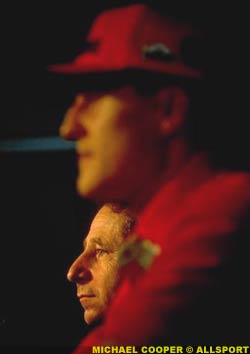Nail-bitingly close racing and a one-two victory for McLaren in the Spanish Grand Prix made a lot of commentators happy. This looks like the beginning of the McLaren fight-back, they said. The season will be lots closer than we thought, they added. These expectations may prove premature.
Barcelona's Circuit de Catalunya is rightly respected as a rigorous test of a racing car's mechanical and aerodynamic grip. It has been the domain of McLaren and before that Williams. It's the one track in the season that Ferrari particularly feared; it only tested there the week before the race and very few days during the winter.  But confounding most expectations the Ferrari was fast at Barcelona. Fast in practice, in qualifying, in the warm-up and in the race. Demonstrating as it did a wicked turn of speed at Barcelona, the Ferrari F1-2000 seems to me to be the car of the season, the one that will win both championships for Ferrari.
But confounding most expectations the Ferrari was fast at Barcelona. Fast in practice, in qualifying, in the warm-up and in the race. Demonstrating as it did a wicked turn of speed at Barcelona, the Ferrari F1-2000 seems to me to be the car of the season, the one that will win both championships for Ferrari.
It's been a struggle to get there. In retrospect, the clunky F310 of 1996 had the aerodynamics of a drag chute. Orders came down from the Ferrari head office to turn it into a Williams replica for 1997. As a result the F310B was too heavy with too small a fuel tank and too much frontal area.
In 1998 the shortfall was in the tire department; Goodyear needed the first six races to get to grips with the challenge of Bridgestone. Last year's F399 was a step forward - as the maker's cup demonstrated - but Michael's Silverstone smash put paid to his championship challenge.
In the meantime, Ferrari has been steadily building up its strength. Its racing staff grew from 450 to 500 people, including the crew that rebuilds Sauber's V-10s. Of the total 135 are designing and developing engines. The test team is now strong enough to be able to test cars in two locations simultaneously. Best of all, says Luca di Montezemolo, "Our core team has been unchanged for three years. That welds them together."
For 2000 Jean Todt and Ross Brawn played musical chairs to give the teams and personnel fresh challenges. Head racing engineer Giorgio Ascanelli moved to R&D and was replaced by Ignazio Lunetta, for some years Schumacher's race engineer. Michael's chief mechanic, Gianni Petterlini, is now the top wrench for the test team. The former Eddie Irvine team has moved across to work with Michael, with Luca Baldisseri as engineer and Frederico Bertazzo as mechanic. The old test team, headed by Carlo Cantoni, now supports Rubens Barrichello.
Even Schumacher has a new organization. Balbir Singh is his new masseur and Xavier Jolis, a Frenchman he met while in hospital in Geneva, is his new trainer. Even more radically, Michael has been learning Italian. Bolstered by his three hours of daily tutoring by Marlene, he addressed the crowd at the launch of the F1-2000 in Italian.
And the car they wheeled out at that conference was a stunner - low, short, compact and light. The Jaguar R1 is considered low; the Ferrari is almost five inches lower. The aerodynamics were refined in Ferrari's new wind tunnel. Best of all, Paolo Martinelli's new 90-degree V-10 is the lightest yet for Ferrari and significantly more powerful, building on the advances that made the Ferraris so quick in the last two races of 1999.
Michael likes it: "For the first time a Ferrari reminds me of the fun of driving a kart. I can be aggressive in the corners and the engine responds wonderfully." This has been all too obvious on the tracks. At Barcelona he was faster than 1999's pole during free practice on Friday, as Ferrari's marketing director reminded me a couple of hours later. Are they staunchly behind him at all levels of the Maranello company? You'd better believe it!

